[full_width]
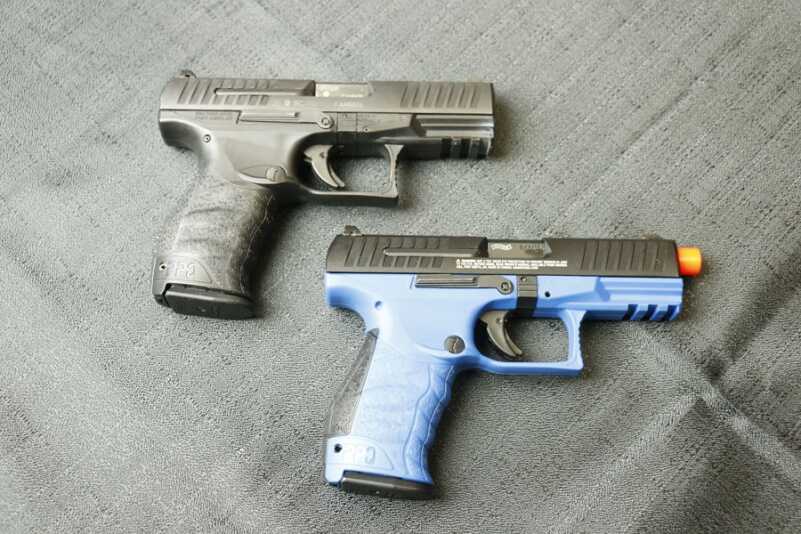
Sometimes you want to train with live-fire, but less-than-lethal force. Walther and Umarex are developing excellent options.
[/full_width]
More about Walther: https://www.waltherarms.com/
More about Umarex: https://www.umarexusa.com/
Check out all of the badass training guns: https://www.t4eguns.com/products/
Buy a Walther at GunsAmerica: https://www.gunsamerica.com/Search.aspx?T=walther
Buy an Umarex at GunsAmerica: https://www.gunsamerica.com/Search.aspx?T=umarex
Not Just a Toy
I’m sure that a good percentage readers of this will immediately think of a toy that shoots plastic BBs when they read “Airsoft.” And let’s be honest–there’s a fair percentage of people out there who would quite enjoy dressing up in full regalia and playing SWAT Cop or Navy Seal against an opposing force. Well, the market that Walther is really looking to tap into with their new line of airsoft guns is not the Fun and Games Division. These guns are designed with the Force-on-Force Training market in mind, and there’s no room for mere toys in that environment. These are not meant for play, and are branded as the T4E line.
[one_half]
[/one_half][one_half_last]
[/one_half_last]
The purpose of training with guns like these is to provide someone with the opportunity to use decision-making skills, while utilizing tools that represent the real thing, but in a safe environment. Such training has to be conducted while maintaining the highest possible levels of student and instructor safety, but at a level of realism higher than that of cap guns and cowboy hats.
[one_half]
[/one_half][one_half_last]
[/one_half_last]
The PPQ GBB LE Blue from Walther fires a 6 mm. Airsoft at 300 ft./s propelled by green gas, utilizing a blowback action and a removable 22 round magazine. This gun features a metal barrel and other metal parts internally, and takes the standard Walther PPQ back straps and sights. All of the controls and dimensions are exact replicas of those found on the real gun. There are two visually-obvious safety features used to differentiate this gun from the real thing: the lower receiver is blue and the barrel tip is a bright red. There is no mistaking this piece of training equipment for a real gun or a child’s toy- both distinctions are very important.
[one_half]
[/one_half][one_half_last]
[/one_half_last]
Force-On-Force Training
Force-on-Force training should be considered a vital activity for those of us who carry a gun every day. This is not a substitute for range work, familiarity with firearms, or basic marksmanship. Force-on-Force teaches decision-making in a dynamic environment- a skill-set that should be of utmost importance to anyone who carries a firearm for self-defense. Not to over-simplify, but the actual BB that is fired is primarily there to avoid the old game we used to play as kids- “Pow! Pow! I got you first!” “No, I got you first!” The no-nonsense thwack of the pellet also serves as a demonstration of whether your tactics will result in a victory or a tie. In a gunfight, a tie is not an acceptable outcome. The purpose of the training is to keep the trainee alive, not just to place a shot on the aggressor at any cost. I mean sure, if the bad guy dies on the scene and the good guy dies in the ambulance after preventing further bloodshed, you could call it a win overall. But that’s not the victory I would choose.
[one_half]
[/one_half][one_half_last]
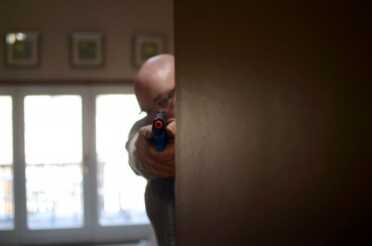
You will quickly discover that clearing your house poses challenges they don’t typically show on t.v.
[/one_half_last]
An equally-important aspect of force on force training is knowing when it’s appropriate to draw the gun at all. We’ve seen plenty of recent stories about concealed carry folks drawing their guns at times that were inappropriate in retrospect. Through training on what happens after your gun is pulled, you learn to better identify situations where de-escalation is the better option. These classes can do wonders for driving home the old adage “Not my problem, not my fight” for those folks who walk around looking for a reason to draw their weapon.
Why Airsoft May be the Perfect Tool
Force-on-Force training has gone through numerous tools over the years. I personally have seen BB guns, paintball guns, and simunition rounds used for such sessions. Each of these has their advantages and disadvantages. I think the bottom line is that the tool needs to simulate combat effectively enough to not be distracting to the role-player, while still being safe. I have seen simunition guns that are particularly finicky and prone to malfunctions, which is obviously distracting, and thus detrimental to the effectiveness of the training. Other platforms have been very propellant-sensitive or overly-complex, and difficult to maintain and supply. I think that Airsoft could be the perfect alternative; the look, feel, and easily-procured ammunition and propellant drastically lower the hardware involvement when planning and executing training exercises. The ultimate requirement has always been the ability to clearly distinguish the training equipment from a real gun, and Walther has accomplished this piece handily with the blue finish. I think this gun will be a big hit.
[one_half]
[/one_half][one_half_last]
[/one_half_last]
Running the Gun in a Scenario
I had the opportunity to run this gun recently in a training environment, and was quite satisfied with its overall performance. I was able to simply hand the student the gun, which was charged and ready to go, and have them holster it before I gave them the scenario. Once the scenario was in progress, the student was free to draw and fire as they deemed appropriate. The gun functioned well, with realistic slide movement and accurate shots placed consistently from up to 15 yards. The only issue we encountered was that the occasional stiff winds would affect the trajectory of the 6mm. plastic BBs. One of the features that I particularly liked was that the gun would lock open once the last round had been fired. Many of the current Airsoft guns on the market will just continue to cycle with an empty magazine unless they run out of gas, which takes us back to the “distraction” issue that was mentioned previously. This gun hits about as hard as I would want- in fact, at close range it may even hit a little too hard. I took a few hits on exposed flesh that left 6mm. blood blisters. I guess this was due to me being the agitator… so I probably deserved it.
[one_half]
[/one_half][one_half_last]
[/one_half_last]
The Bottom Line
As an instructor of Force on Force training, I think that there are a handful of requirements that must be met for this training to be effective. The first and foremost requirement is safety, and this is accomplished well by the new Walther PPQ Airsoft pistol. Secondly, the equipment used must be simple and reliable. This requirement was certainly met. The training gun must also be realistic, so as not to distract from the scenario, and this pistol exceeded all expectations in that regard. This Walther is definitely the best airsoft pistol I have ever used, by far. I don’t know if I would want to use this to play Navy Seal (those BBs hurt, and I don’t have the legitimate gear for that) but to train someone on how to make good decisions with a firearm, there is no other imitation pistol I would want at hand.
Retail should be $99.95.
[full_width]
[/full_width]



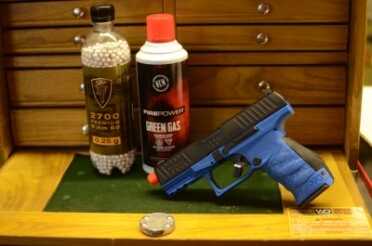
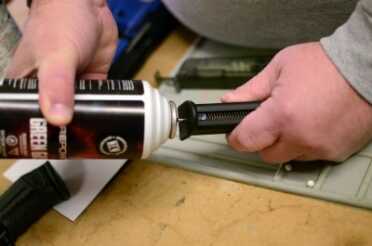
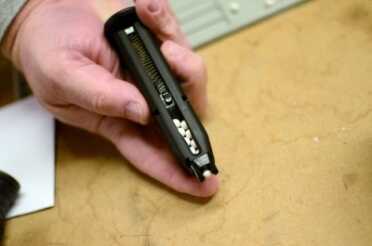
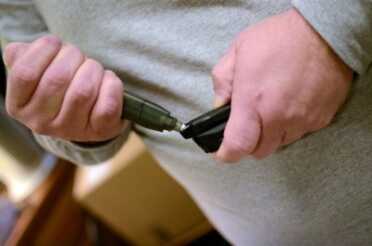
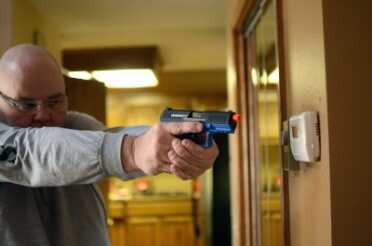
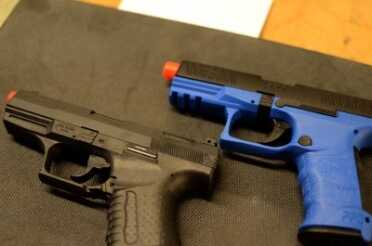
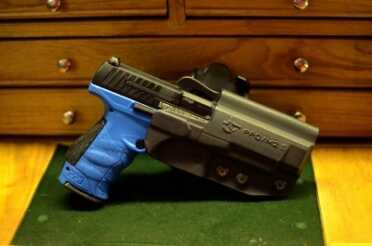
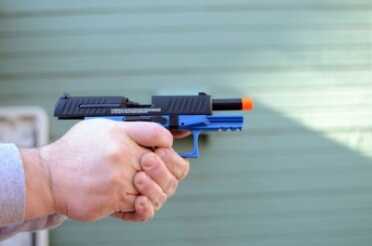
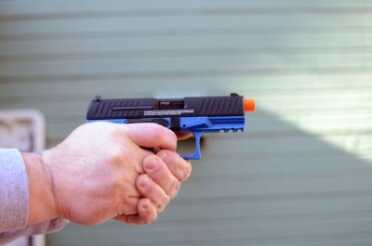
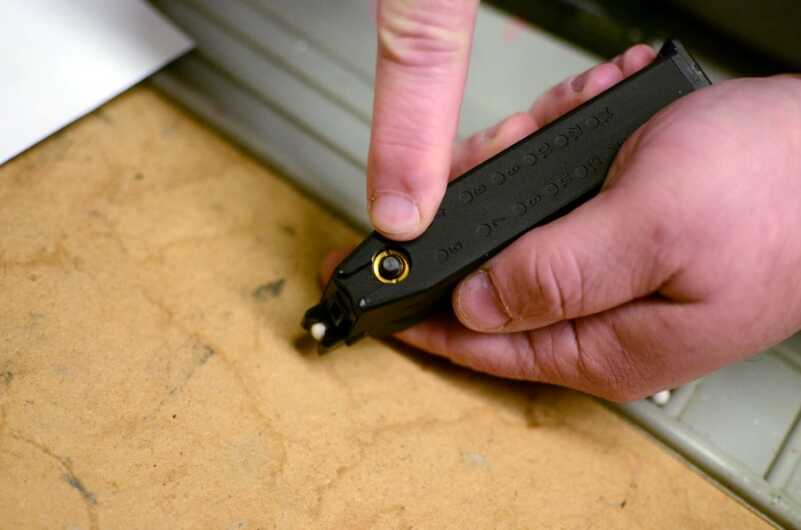
I have been training with airsoft and UMT rounds in a 22,000 square foot facility for almost three years. This is a membership, professionally run organization.
I shoot IDPA, USPSA, Three gun and Cowboy action shooting. Here are the major points of what I have learned participating in this type of training. I have yet to come across any individual who shoots that when the subject comes up about “shooting being a perishable skill” adamantly agree. Well from my perspective, if you think shooting is a perishable skill (which of course it is) then force on force training is ten times more perishable than just shooting.
Addressing the friendly fire issue. Inside our facility is a three bedroom house, two bathrooms and a upstairs. A bank complete with four teller windows, loan officers offices and a lounge area. A condo building with movable walls. All of these buildings do not have roofs but rather a catwalk on top so the instructors can watch the activity for a later debriefing. In the open area between these buildings there is room for at least 6-7 vehicles. During the course of the last three years I have frequently worked with first timers to this type of training. One of the best training activities is a “night simulated” civilian group (CCW) that is looking for a life like 14 month old child. As a group of “good guys” we have no idea how many “bad guys” there are out in the training area. We are not there to shoot or kill anyone. We are there to retrieve the child without getting shot.
I have found in our pre-exercise meeting is to select a leader. Even though I have the most experience I usually don’t play that role unless I can’t get a volunteer. I explain to them that as the leader they need to tell the group what the moves are going to be and I am not going to move unless they instruct me to move. That way they will always know where I am at. It is also the responsibility for any of us to tell the leader that you don’t not understand their instructions. Let me be clear. The leader’s role is not to tell the members of the group how to move and where to move or stand. The instructions are to accomplish a certain task and when finished to meet here! Or to cover this area. But the bottom line is that everyone in the group knows who is supposed to be in this area. Not reality is that it does not always work out this way. But it does improve the chances of not getting shot by your group member.
If you conceal carry you should really seek out this type of training. You will learn how to use light as in your flashlight, how to use light to your enhance your concealment, and mostly how to “see” things.
As long as I am financially able and physically able to train like this I will continue. Personally, knowing what I know now. It would be hard for me to conceal carry without this type of training.
Enthusiastically yours,
KR Reinschmidt
Another couple of notes about the value of airsoft training.
In my experience with a variety of gas and electric guns, their magazines will jam/malfunction at a higher rate than firearms. It’s not a constant/common thing with good airsoft guns and mags, but definitely more common that with qualify firearms. I consider this a good thing, because I have had to do lots of unexpected mag-change-and chamber in the midst of airsoft gunfights. If you are carrying your spare mags the way you would be carrying them for a firearm, this is valuable training experience.
I also use a dump pouch, so for non-emergency mag changes, airsoft has contributed to the speed and fluidity at which I can change mags and recover/secure the spent or partially empty mag.
Friendly fire is more of a hazard than you would think if you have never done force on force training. While it is rare that I have “killed or injured” a teammate. It has happened. It happened more in the early days and avoiding engaging a friendly by accident has become one of my constant priorities in airsoft training. Also, most of my point-blank range hits (which suck to receive) have come from poorly disciplined people on my own team who were surprised to encounter me so near the “front line.” This has taught me that most civilians cannot be trusted to “back you up” unless you remain in sight of them at all times. Though a gunfight involving multiple persons on both sides is rare in the civilian world, making sure your side knows who and where you are at all times possible is something airsoft continually reinforces (and painfully at that).
Finally, while I mentioned use of cover (being able to quickly get into cover, minimally expose yourself while firing, etc) I failed to mention all I have learned about the use of concealment. After lots of head to head gunfights in airsoft matches, I have learned to always, whenever possible, conceal myself from the enemy while identifying their positions/movements, and position myself in order to engage them while they are facing another direction. Shooting someone “in the back” or when they aren’t prepared for it is a dirty move, but it beats taking return fire every time.
One additional note about airsoft gun types:
Gas guns won’t work well in the cold, so there is a reason to use electric, sometimes, even if you prefer the more realistic deal of gas. “blowback” electric rifles are available that more faithfully reproduce the action of a firearm. Also magazines for gas guns are more expensive than those for electric, becaus part of the gun’s operating mechanism is actually inside the magazine, whereas electric gun mags are only ammunition feeding devices. When it comes to choosing a gun for training, shelling out more money for a “full metal” gun is worth it. They are more durable when dropped, slammed into walls/cover etc, and have a weight very close to the real firearm. The less expensive, mostly plastic guns work well and are a good budget/starter gun, but they don’t remind you how hard it is to hold a rifle up on target or on a lane of fire for any length of time after carrying it for hours.
A quick note about gas powered airsoft guns: You should NOT “safely de-gas the magazine after training.” Green gas powered magazines need to stored with a partial gas charge to ensure longevity and functionality of the gas reservoirs and valves within them. Ask any tech who works on airsoft guns. The “button” on the back is not a safety/clearing devise. It is actuated by the mechanism when firing and is how the gun releases a gas charge for each shot. It is also a reliable way to verify there is a gas charge in the mag, not by pushing it, but just by gently pressing to verify it is under pressure. To make the mag “safe” just remove the BBs and don’t put the magazine back in the gun.
I have been using airsoft as a training (and exercise!) tool for years now. You can only accomplish so much with dry fire or live range fire. Until you start negotiating diverse environments with realistic firearms replicas, identifying, prioritizing, and engaging threats, and using smart maneuvers and use of cover, you are a looooong way from prepared for a gunfight no matter how accurately you can shoot.
That’s the importance of force on force training. LE and military that could access simunitions have been doing it a long time, but airsoft has made it viable to more LEO’s and civilians. it gives you an idea of how well you can really see/ID threats or weapons/sights in different lighting conditions, how fast you can react, and how well you can move with a weapon. As long as you have plenty of “real steel” shooting experience, you can factor in the lack of recoil and muzzle flash and how it affects your rate of fire and vision. If you’ve never done force on force, look for a place to try it out near you. Many places offer rental guns that are an AR15 variant (albeit an electric and not gas powered rifle). If you get into the sport, there are reliable/accurate replicas for most common rifles and handguns (and even some shotguns) so many people can train with what they carry or keep for home defense.
Thank GOD for Walther, for giving us the means to train people effectively. Anyone who puts a firearm in an active training is a gun NUT! Real is for the range, Pellets are for the principles.